Mexico › Zacatecas
Updated: March 3, 2022
See Also
- Mexico – Where to Go
- Mexico – With Kids
- Mexico – Best Time to Visit
- Mexico – Best Beaches
- Mexico – Cancun vs Tulum vs Playa del Carmen
Zacatecas is one of our favorite historic Mexican cities, a colonial gem crammed with gorgeous old buildings, churches, and museums. It’s setting in a valley between two hills is spectacular, and there are also tours of the old silver mines and a cable car ride high over the rooftops. Wandering its cobbled streets and leafy plazas, it’s easy to feel transported back to classical Spain.
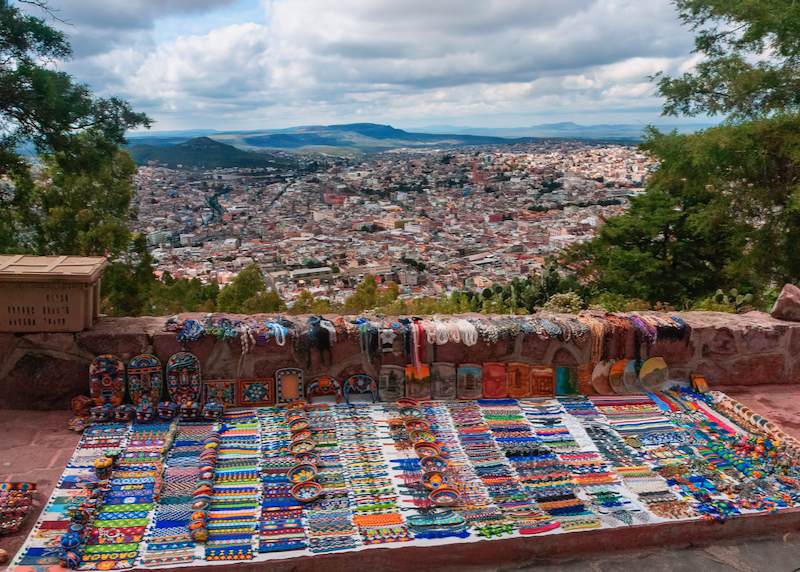
View from Cerro De La Buffa mountain, with beaded folk art and jewelry for sale and a view of the city of Zacatecas below, a UNESCO World Heritage Site.
Frequently Asked Questions about Zacatecas
Where is Zacatecas?
Zacatecas is a city in the central region of Mexico known as the Bajío and is the capital of the eponymous state of Zacatecas. Zacatecas lies around 600 km northwest of Mexico City, 300 km northeast of Guadalajara, and 560 km southwest of Monterrey.
Non-stop flights to Zacatecas take 1 hour 25 minutes from Mexico City, 2 hours 20 minutes from Dallas, 2 hours 40 minutes from Tijuana, 2 hours 55 minutes from Los Angeles, and 3 hours 50 minutes from Chicago.
How big is Zacatecas?
Zacatecas has a greater metro population of almost 140,000. The city lies on the edge of the Sierra Madre Occidental and covers some 444 square kilometers.
What is the history of Zacatecas?
The indigenous Zacatecos mined silver and precious metals in the hills here long before the arrival of the Spanish, but it didn’t take long for the conquistadors to grasp the area’s potential. The modern city was initially founded as a Spanish mining camp in 1548, with the Zacatecos quickly subdued. For the next three hundred years, the silver mines of Zacatecas enriched the city, Mexico, and the Spanish Empire. During the Mexican Revolution in 1914, Zacatecas was the scene of fierce fighting when Pancho Villa’s División del Norte captured the city, completely annihilating the forces of Victoriano Huerta. Today Zacatecas is flourishing once more, its economy boosted by increasing trade between Mexico and the USA.
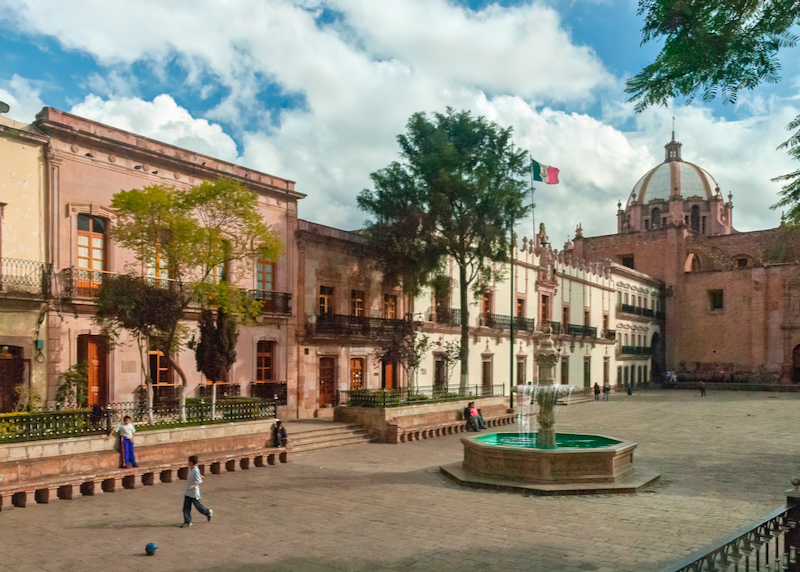
A plaza downtown outside of the Palace of the Governor, with the Cathedral of Our Lady of the Assumption behind.
How do I get to Zacatecas?
Convenient non-stop flights connect Zacatecas with Chicago, Dallas, and Los Angeles in the US. There are also non-stop flights to Tijuana airport, which is directly accessible from the US border near San Diego. Otherwise, most other flights route through Mexico City (there are no non-stop flights from Canada or Europe).
Zacatecas airport is 27km north of the city center. The only way to get into the center is by taxi; airport taxis charge a fixed rate of around M$400 (ask the hotel to arrange one for the trip back).
Within Mexico, first-class long-distance buses are an economical and comfortable alternative to flying – to Zacatecas, there are frequent long-distance bus services to the cities of northern Mexico, the Bajío, and Mexico City (6–8hr).
Can I use Uber in Zacatecas?
Assuming phones have roaming, and the app works, Uber is available in Zacatecas and can save up to 50 percent on journeys to and from the airport, though drivers may be reluctant to pick-up thanks to hostility from the airport taxi union. Email the hotel for advice on the latest situation. Once in the city itself, there should be no problems using Uber.
Can I drive to Zacatecas?
Driving down to Zacatecas from the US border is relatively straightforward, and plenty of Americans and Canadians take their own vehicles – the main highways are good, and virtually empty outside the cities. However, care should be taken in choosing a route, as the Mexican border states suffer from high levels of drug violence – driving at night should definitely be avoided. Foreign vehicles also need a Mexican “Temporary Importation of Vehicle Permit”, arranged at the border.
From Laredo, Texas the drive is around 422 miles (679 km) and takes around 9 hours non-stop. Zacatecas is 765 miles (1231 km) from El Paso, Texas (15 hours), and 1370 miles (2205 km) from San Diego, California.
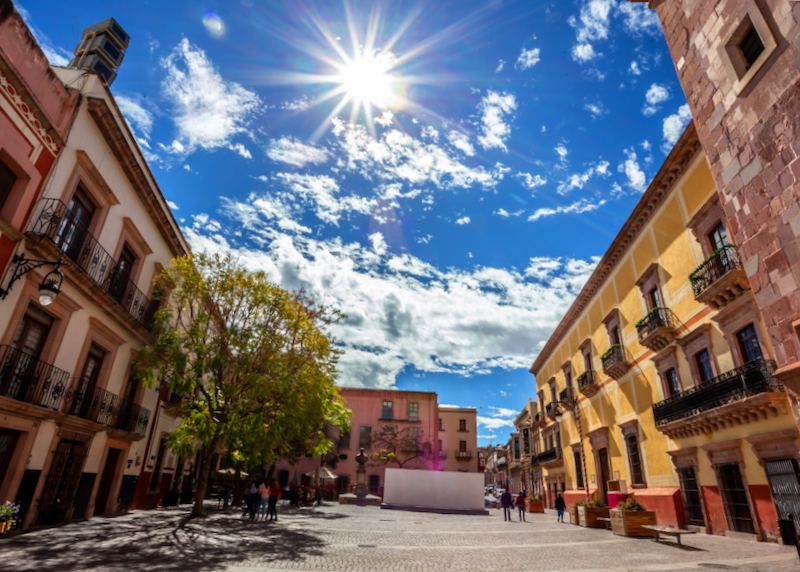
A pedestrian street in the vibrant city center.
Do I need a car in Zacatecas?
Cars are not necessary in Zacatecas. Once in town, it should be able to get around on foot, though taxis (and Uber cars) are easy to find. Meters in regular taxis start at 11 pesos (minimum 25 pesos for rides in the center).
When is the best time to go to Zacatecas?
Zacatecas lies at well over 2000 meters (6562 ft) above sea level, and experiences relatively dry, mild weather year-round. March through May tend to be the best months to visit – sunny, warm, and dry. June through October can be rainy, and winters tend to be cooler. As always, avoid Christmas, Easter, and all major Mexican holidays to avoid the crowds (it’s a popular destination for Mexican domestic tourists).
Where should I stay in Zacatecas?
Aim to stay in the atmospheric center of old Zacatecas, close to all the sights, best restaurants, and attractions. Motel chains have sprung up around the city, near the major highways, and can offer good rates, but these are all a long way from the action and it can be hassle shuttling back and forth.
Some of our favorites places to stay include the lavish but surprisingly affordable Hotel Emporio, the colonial Mesón de Jobito and luxurious Santa Rita del Arte.
For something really special, stay at the Quinta Real, tastefully incorporated what was once Zacatecas’ bullring. The best of the budget accommodation is no-frills Hostel Villa Colonial (Primero de Mayo 201, at Callejón Mono Prieto + 52 492 925 0749)
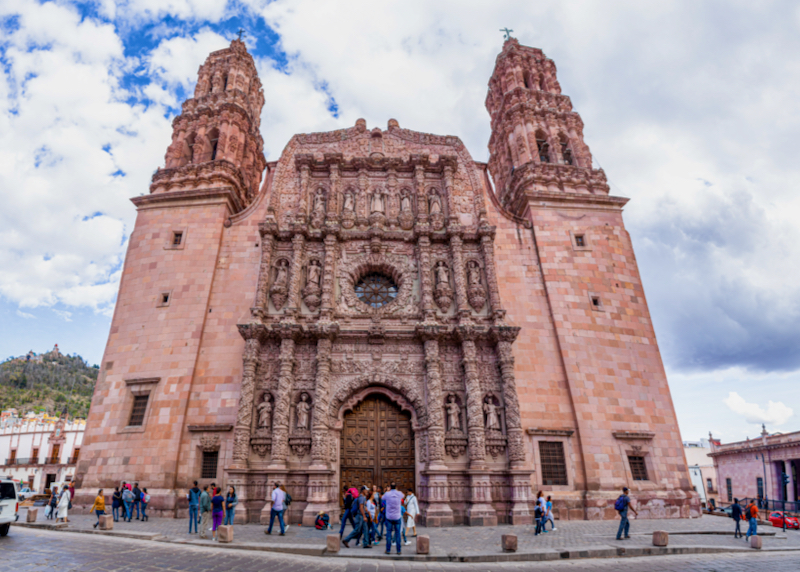
The facade of the Zacatecas Cathedral.
What are the best things to do in Zacatecas?
Start by simply wandering the cobbled streets and historic colonial plazas of Zacatecas. The city’s gorgeous, pink sandstone cathedral is one of the best examples of Mexican Baroque architecture in the country. Nearby, the old market, Mercado González Ortega, has been converted into a chic shopping mall. As befits such a historic city, Zacatecas is also crammed with absorbing museums. The Museo Pedro Coronel (Plazuela de Santo Domingo) showcases the modern, abstract, and Catalan art collected by local artist Pedro Coronel (including work by Picasso and Miró). Pedro’s brother Rafael founded his own beautiful museum, the Museo Rafael Coronel (Callejón de San Francisco 65), set in an old Franciscan mission and built around a vast collection of traditional masks.
The Museo Zacatecano (Dr. Ignacio Hierro 307), housed in the old mint, chronicles the history of the region, while the Museo de Arte Abstracto Manuel Felguérez (Cristóbal Colón) displays the abstract paintings and sculpture of local artist Manuel Felguérez, inside a converted prison. The Museo Francisco Goitia (Enrique Estrada 102) highlights the work of yet another Zacatecan artist, Francisco Goitia.
The mining history of Zacatecas is the focus at the fascinating Mina El Edén, where guided tours take you deep inside the city’s old silver mine.
Once done with the city sights, take the Teleférico (cable car) up to the Cerro de la Bufa, the huge rock that dominates the city, for spectacular views and the Museo de la Toma de Zacatecas, which recounts Pancho Villa’s desperate attack in 1914. There’s also a decent zipline up here, Tirolesa 840.
What are the best things to do around Zacatecas?
Zacatecas makes a good base to explore the surrounding area. Highlights include the traditional silversmiths at the Centro Platero de Zacatecas and the ornately decorated church in neighboring Guadalupe, the ruins of the great Mesoamerican fortress at La Quemada (56 km south of Zacatecas), and the picturesque town of Jerez (53 km west of Zacatecas). Buses link all these sites with the city, though it’s best to take a guided tour to visit La Quemada (easily arranged at the hotel).
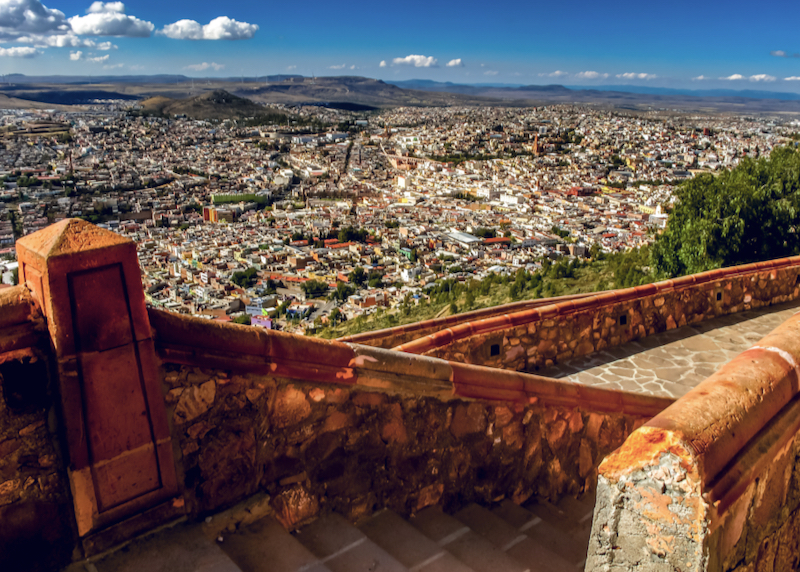
The view from the Cerro de la Bufa hilltop above the city.
What are the restaurants like in Zacatecas?
Zacatecas restaurants are good – primarily Mexican food, though standard American dishes (burgers and the like) and Italian food are widely available. The local specialties include “asado de boda” (braised pork with chocolate and orange zest), and anything “zacatecano”, usually involving a sauce of poblano chilies and cream. We love Acrópolis, an old-world café with its own impressive art collection, and cozy Dorados de Villa (on Plazuela de García), which knocks out excellent moles and enchiladas. The best place for a relaxing coffee (and free wi-fi) is Il San Patrizio Caffé (Hidalgo 403). For a splurge, book a table overlooking the old bullring at La Plaza, in the Quinta Real hotel.
What currency is used in Zacatecas?
The Mexican peso (often prefixed with a “$” sign) is the currency of Mexico and Zacatecas. Most major shops and restaurants in Zacatecas accept credit cards, but it is a good idea to have some peso cash on hand for entry fees and small purchases like bottled water and snacks. ATMs are easy to find in central Zacatecas – and generally get a better exchange rate here or inside banks than at currency exchange booths.
Is Zacatecas expensive?
Zacatecas is not expensive. Hotels in Zacatecas are reasonably priced given their quality, and eating out is rarely expensive. Transportation is inexpensive and fees to enter museums are low, typically one or two US dollars equivalent (tours of the mine and trips on the cable car are closer to US$5).
Is Zacatecas safe?
Zacatecas has generally avoided the drug violence that has affected other parts of Mexico making it a safe destination to visit. US State Department travel warnings generally apply to the western part of the state of Zacatecas (south of Highway 45 and west of Highway 23) and not the city itself. Take the usual precautions, especially at night, and keep valuables in room safes.
Read More
- Cancun – Best Hotels
- Cancun – Family Hotels
- Isla Mujeres – Best Hotels
- Isla Mujeres – Family Hotels
- Los Cabos – Travel Guide
- Los Cabos – Best Hotels
- Los Cabos – Family Hotels
- Mazatlan – Best Hotels
- Mazatlan – Family Hotels
- Playa del Carmen – Best Hotels
- Playa del Carmen – Family Hotels
- Puerto Vallarta – Best Hotels
- Puerto Vallarta – Family Hotels
- Punta de Mita – Best Hotels
- Sayulita – Best Hotels
- Tulum – Best Hotels
- Tulum – Family Hotels